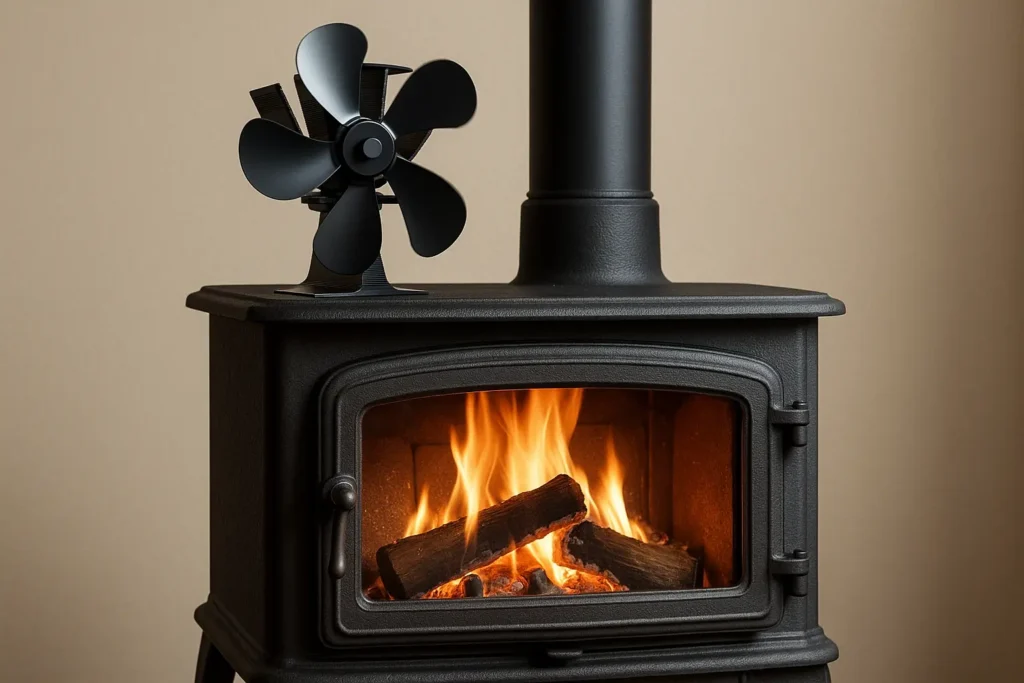Introduction
If you’re using a wood stove to heat your home, you might have noticed the warm air doesn’t always spread evenly. That’s where a heat powered wood stove fan comes in. These small, silent devices sit on top of your stove and help circulate warm air more efficiently—without using electricity. In this guide, we’ll explore how they work, their benefits and drawbacks, popular models, and tips on installation and maintenance. Whether you’re new to off-grid heating or upgrading your stove setup, this post is packed with practical insights.
What is a Heat Powered Wood Stove Fan?
A heat powered stove fan, also known as an eco stove fan or self-powered stove fan, is a compact device placed on top of a wood-burning stove. It uses the stove’s heat to generate electricity and spin the fan blades—no need for batteries or external power.
How Does It Work?
At first glance, it might seem like magic that a fan can spin without being plugged in—but the secret lies in a clever bit of science. A heat powered stove fan operates using a thermoelectric module (also called a Peltier device), which creates electricity from the difference in temperature between the base and the top of the fan. When you place it on your hot wood stove, the bottom heats up while the top stays cooler, thanks to built-in heat sinks. This temperature difference generates a small amount of electricity, just enough to power a quiet little motor that spins the fan blades.
It’s an elegantly simple system—no wires, no batteries, and no fuss. The fan starts spinning as the stove heats up, and it slows down as the stove cools. Because it’s self-powered, it’s perfect for off-grid homes or situations where you want to improve heating efficiency without raising your energy bill. You’ll notice that the warm air spreads faster and more evenly throughout the room, especially in spaces that previously had hot spots near the stove and cold corners farther away.
Key Technical Features to Look For
When shopping for the best wood stove fan, consider the following specs:
| Feature | Description |
|---|---|
| Operating Temperature Range | Most fans work between 50°C–350°C (122°F–662°F). Ideal performance is at 150°C+ |
| Airflow Output (CFM) | Ranges from 100 to 270 CFM (Cubic Feet per Minute). Higher CFM = more warm air circulated. |
| Blade Count | Typically 2 to 5 blades. More blades often mean better airflow. |
| Material | Anodized aluminum for better heat resistance and rust-proofing. |
| Noise Level | Almost silent due to no motor hum or electrical noise. |
Pros and Cons of Using a Heat Powered Stove Fan
Let’s be real—no device is perfect, and a heat powered stove fan is no exception. But for most wood stove owners, the benefits far outweigh the drawbacks.
On the plus side, these fans require no external power, making them ideal for off-grid cabins, backup heating during power outages, or anyone who wants a greener home. Because they use your stove’s existing heat, they’re incredibly energy-efficient. You’ll enjoy better heat distribution throughout your space—no more roasting near the stove while your feet stay cold across the room. They also run nearly silent, which is a big bonus for anyone who appreciates peace and quiet.
That said, there are a few limitations. These fans only work on flat, hot surfaces like those found on traditional wood stoves, so they’re not suitable for pellet or gas models. Their effectiveness is typically limited to single-room use, and while they’re durable, most models will wear out after a few seasons of heavy use. Still, considering their low cost and zero operating expenses, many people find them to be a worthwhile and reliable addition to their winter heating setup.
Top Heat Powered Wood Stove Fans in the Market (2025)
Here are some best-selling and highly-rated models available in 2025:
| Model | Airflow (CFM) | Temp Range | Key Features | Best For |
|---|---|---|---|---|
| Ecofan AirMax (Caframo) | Up to 175 | 85°C – 345°C | High efficiency, quiet, durable build | Medium to large rooms |
| VODA 4-Blade Fan | 180 – 200 | 85°C – 350°C | Budget-friendly, 4-blade design | Everyday home use |
| Tomersun 3-Blade Fan | ~150 | 85°C – 340°C | Compact size, built-in thermometer | Small spaces, cabins |
| VonHaus 4-Blade Fan | ~190 | 60°C – 340°C | Sleek design, solid airflow | Style-conscious users |
| Galafire Wood Stove Fan | ~170 | 50°C – 345°C | Magnetic thermometer included | First-time buyers |
Installation & Usage Tips
Installing a stove fan is incredibly easy, but here are a few tips to get the most out of it:
-
Place it at the back or side of your stove — not directly over the hottest part.
-
Keep it on a flat, smooth surface for better heat transfer.
-
Allow proper airflow around the fan — don’t place items too close.
-
Use a stove thermometer to monitor temperatures and avoid overheating.
⚠️ Never handle the fan when hot. Let it cool before moving or cleaning.
Frequently asked questions (FAQs)
No. They require a flat, hot surface like those found on wood-burning stoves.
Wait until it’s cool. Use a soft cloth to remove dust. Avoid water or harsh chemicals.
Not always. A fan with moderate CFM but better placement can outperform a higher CFM fan in poor positioning.
Most come with built-in safety features or bimetallic strips to lift the fan base off the stove if it gets too hot.
Final Thoughts
If you rely on a wood stove to heat your space, a heat powered stove fan is a simple, cost-effective upgrade. It helps you maximize your stove’s potential by distributing warmth more efficiently—without raising your energy bill. Whether you’re prepping for winter or living off-grid, this little gadget packs a punch.

